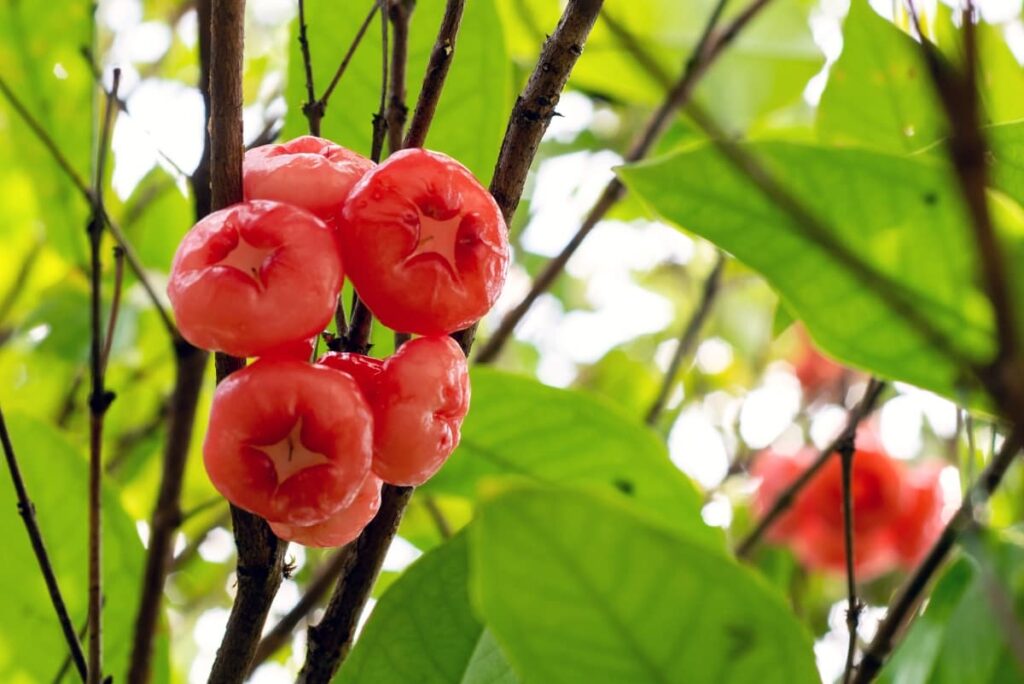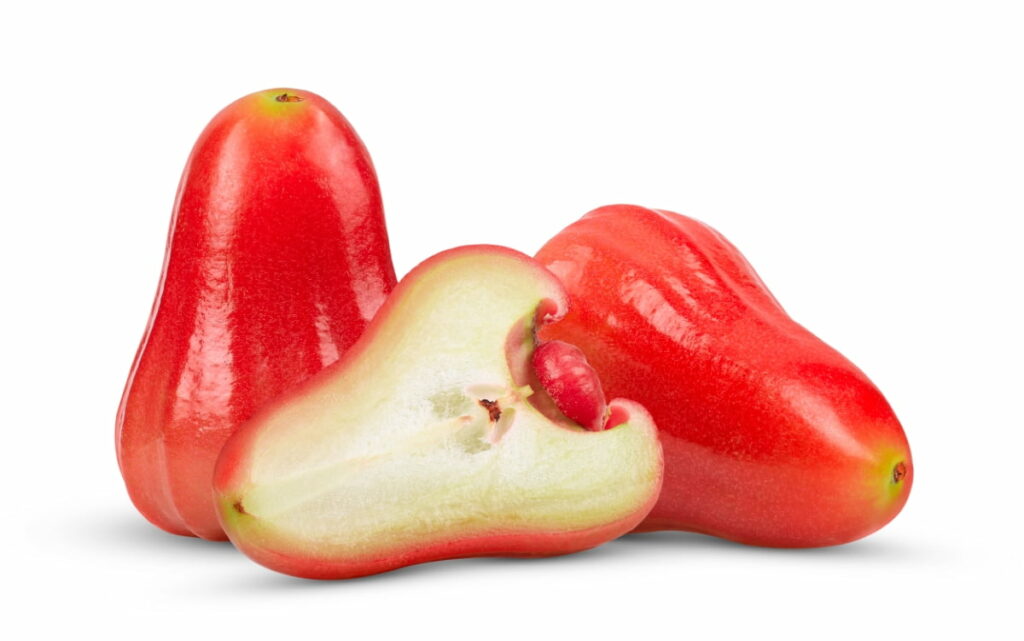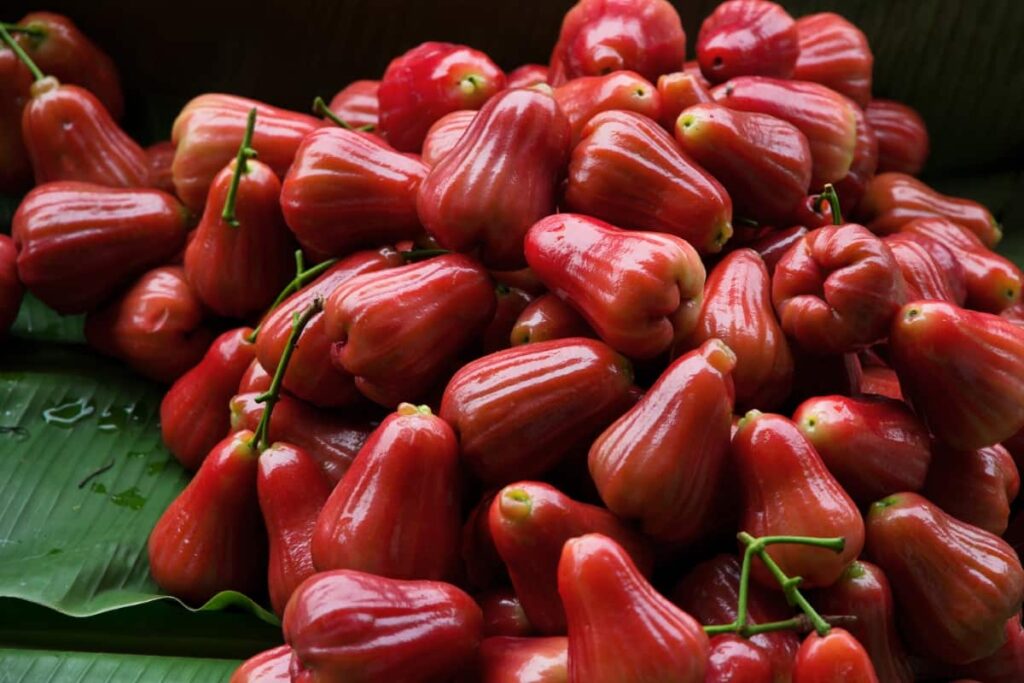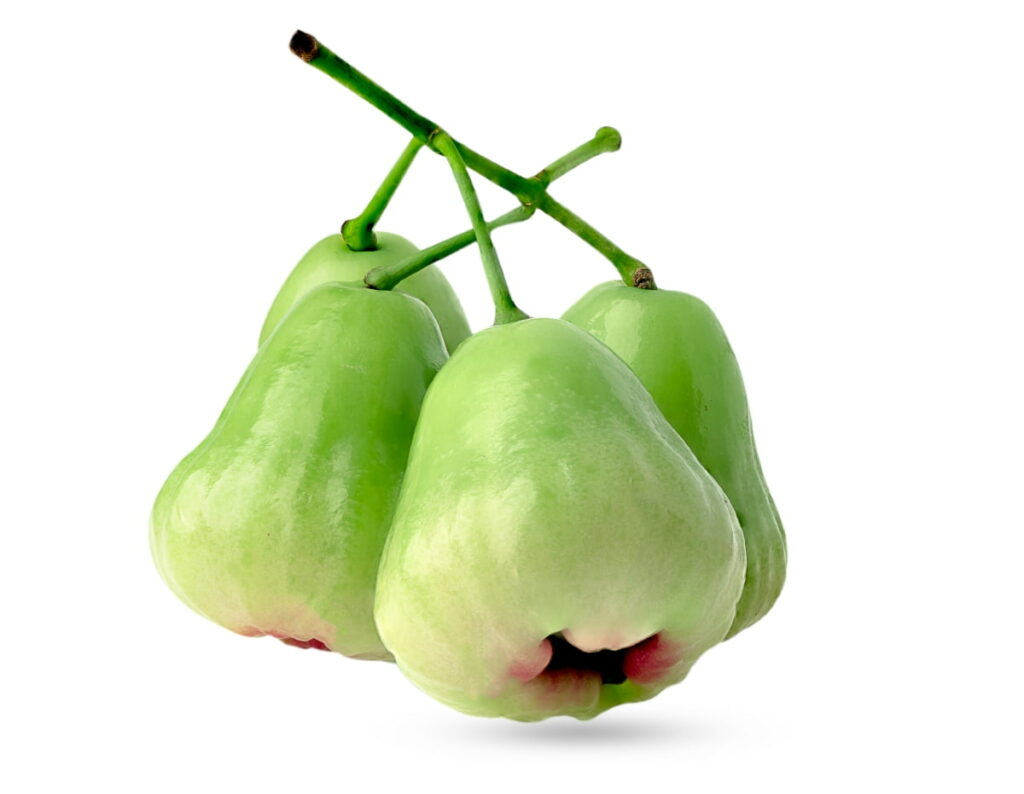Growing Java apples, also known as water apples or rose apples, in home gardens can be a rewarding endeavor for beginners. These tropical fruits thrive in warm climates and are prized for their crisp texture and sweet flavor. In this comprehensive guide, we’ll delve into the essential steps and Java apple care for successfully cultivating Java apples at home. This guide covers everything you need to know to embark on your journey as a Java Apple gardener. Get ready to enjoy the java apple fruits of your labor right from your backyard!

How to Grow Java Apple in Home Gardens
Other Names of Java Apple
- Syzygium samarangense (scientific name)
- Water apple
- Rose apple
- Bell fruit
- Wax apple
- Malay apple
- Jambu air (in Malay)
- Chomphu (in Thai)
- Jambu air merah (in Indonesian, meaning “red water apple”)
Climate and Location
Tropical Climate: Java apples thrive in tropical climates characterized by warm temperatures and high humidity. Ideal temperature ranges for Java apples typically fall between 20°C to 35°C, although they can tolerate slightly cooler temperatures for short periods.
Sunlight: Ensure that your chosen planting location receives full sunlight for at least six to eight hours daily. Avoid planting in shaded areas or spots with insufficient sunlight, as this can hinder the tree’s development and yield.
Soil Preparation
Well-Draining Soil: Java apple soil requirements include well-draining soil, which allows excess water to escape freely. Before planting, the soil should be loose and well-aerated to promote healthy root growth. Amending the soil with organic matter such as vermicompost or aged manure can improve drainage and soil structure.
pH Level: Aim for a slightly acidic to neutral soil pH range from 6.0 to 7.0. Conduct a soil pH test to determine the pH level of your planting site. If necessary, adjust the pH using appropriate amendments, such as lime to raise pH or sulfur to lower pH.
Propagation
Propagation of Java apples can be achieved through seeds or vegetative methods like grafting or air layering. Seeds should be collected from ripe fruits, cleaned, and sown immediately in well-draining soil. Grafting involves joining a desired Java apple variety onto a compatible rootstock for faster fruit production and consistent quality.
Air layering involves inducing roots to form on a branch without separating from the parent tree, allowing for the creation of genetically identical plants. Regardless of the method chosen, ensure proper care and attention to establish healthy young Java apple plants ready for transplanting.
Planting
Seedlings or Grafted Trees: When planting Syzygium Samarangense (Java Apples), you can choose between seedlings or grafted trees. Seedlings are grown from seeds and may exhibit variability in fruit quality, while grafted trees offer consistent fruit characteristics. To plant seedlings, dig a hole a bit larger than the seedling’s root ball, gently place the java apple seedling in the hole, and backfill with soil.
Spacing: Space your tropical java apple tree according to its mature size to ensure proper airflow, sunlight penetration, and efficient harvesting. Plant approximately 15 to 20 feet of space (4.5 to 6 meters) between trees to accommodate their spreading canopy and root system.
In case you missed it: How to Grow Tej Patta at Home: Planting and Caring Bay Leaf Plant

Mulching
Applying mulch around the base of Java apple trees offers numerous benefits, including moisture retention, weed suppression, and soil temperature moderation. Spread an organic mulch, like wood chips or shredded bark, around the root zone. As wax apple gardening tips, leave a gap around the trunk to prevent rot. Maintain 2 to 4 inch thickness (5 to 10 centimeters) of mulch, replenishing it as needed to maintain thickness.
Support for Young Trees
Provide support for young Java apple trees to encourage upright growth and prevent damage from strong winds or heavy fruit loads. Install stakes or trellises near the tree, ensuring they are firmly anchored into the ground and positioned to support the main trunk. Secure the tree to the support structure using soft ties or tree straps, avoiding tight binding that could restrict growth.
Watering
Regular Watering: Water newly planted trees deeply to ensure the root ball is thoroughly moistened, then maintain watering regularly to keep the soil moist but not waterlogged. Provide approximately 1 to 2 inches (2.5 to 5 centimeters) of water per week, adjusting based on weather conditions and soil moisture levels.
Humidity: Aim for humidity levels ranging from 60% to 80% to create a favorable microclimate for Java apple trees. Supplemental measures such as misting or placing trays of water near the trees can help increase humidity levels in dry climates or during periods of low humidity.
Fertilization
Balanced Fertilizer: Use a balanced fertilizer with an NPK ratio of around 10-10-10 or similar, providing essential nutrients in proportions suitable for Java apple tree fertilization. Apply fertilizer evenly around the drip line of the tree. Avoid direct contact with the trunk, and water thoroughly after application to facilitate nutrient uptake.
Regular Feeding
- In Java apple fruit cultivation, During the first year after planting, avoid fertilizing to allow the young tree to establish its root system.
- In the second and third years, apply a balanced fertilizer (10-10-10 NPK) three to four times a year.
- For mature Java apple trees, fertilize two to three times a year.
- Apply fertilizer in early spring before the growing season begins, again in mid-summer, and optionally in late summer or early fall if growth appears sluggish.
Pruning
Shape and Size: Pruning Java apple trees promotes optimal sunlight penetration, airflow, and fruit production. Prune during the dormant season, removing any crossing or inward-growing branches to open up the canopy and encourage outward growth. Maintain a balanced shape with a central leader and well-spaced lateral branches.
Remove Dead Branches: Prune dead, diseased, or damaged branches to control the spread of pests and diseases and promote overall tree health. Use sharp, clean pruning tools to make clean cuts, avoiding leaving stubs that can attract pests or pathogens. Dispose of pruned material properly to prevent contamination and maintain a tidy growing environment.
Pest and Disease Control
Monitor Regularly: Inspect the foliage, branches, and fruit of Java apple trees regularly, at least once a week during the growing season. Look for pest damage signs, such as chewed leaves or discolored spots, and symptoms of diseases like leaf spots or wilting.
Organic Pesticides: Utilize organic pesticides to control pests and diseases while minimizing environmental impact. Neem oil, extracted from the neem tree’s seeds, acts as a natural insecticide and fungicide, disrupting pest life cycles and suppressing fungal growth. Additionally, insecticidal soap and horticultural oil effectively control aphids, mites, and scales by suffocating them on contact.
Harvesting
Fruit Ripening: Java apples typically ripen 4 to 6 months after flowering, depending on the cultivar and growing conditions. Ripe fruits exhibit a uniform coloration, usually red or pink, with a firm texture and sweet aroma.
In case you missed it: How to Grow Gongura from Seeds and Stems in Home Garden: Planting Tips for Terrace, Backyard, and Pots

Harvesting Time: Harvesting Java apples when they reach full maturity, typically in late summer or early fall. Use pruning shears to cut the fruits from the tree, leaving a short stem attached. Carefully handle the fruits to avoid bruising or damaging the delicate skin. Store harvested Java apples in a cool, dry place, or enjoy them fresh from the tree for the best flavor and texture.
Growing Java Apple in Containers
- Choose a container with drainage at the bottom to accommodate the tree’s root system and provide good airflow.
- Use a well-draining potting soil with organic matter to promote healthy growth.
- Place the container in a sunny area, ensuring the tree receives 6 hours of sunlight daily.
- Regularly water and fertilize with a balanced fertilizer during the growing season to support growth and fruit production.
- Prune the tree as needed to maintain size and shape.
Yield of Java Apple per Tree
The yield of Java apples per tree can vary based on factors like tree age, health, and growing conditions. Generally, a mature and healthy Java apple tree can produce 700 fruits anywhere per season.
In case you missed it: How to Get Rid of Rats in the Home Garden Naturally: 10 Natural Home Remedies for Repelling Rats

Conclusion
Growing Java apples in home gardens offers a rewarding experience for beginners, providing an abundance of sweet and crisp fruits with proper care and attention. This ultimate guide equips beginners with the knowledge and confidence to embark on a successful journey of Java apple cultivation.
- Profitable Village Farming Business Ideas in 2024
- High-Yield Aquaculture: Fast-Growing Fish for Farming
- Effective Fish Pond Construction Techniques for Beginners
- Irrigation and Water Management in Pineapple Farming
- Blossom to Harvest: Mastering Flowering and Pollination in Papaya Farming
- Pig Fattening Essentials: From Selection to Sale for Beginners
- Raising Wagyu Cattle: A Complete Guide for Premium Beef Production
- Soil Types and Their Water Holding Capacity
- Optimizing Irrigation Schedules for Coconut Groves for Enhanced Yield
